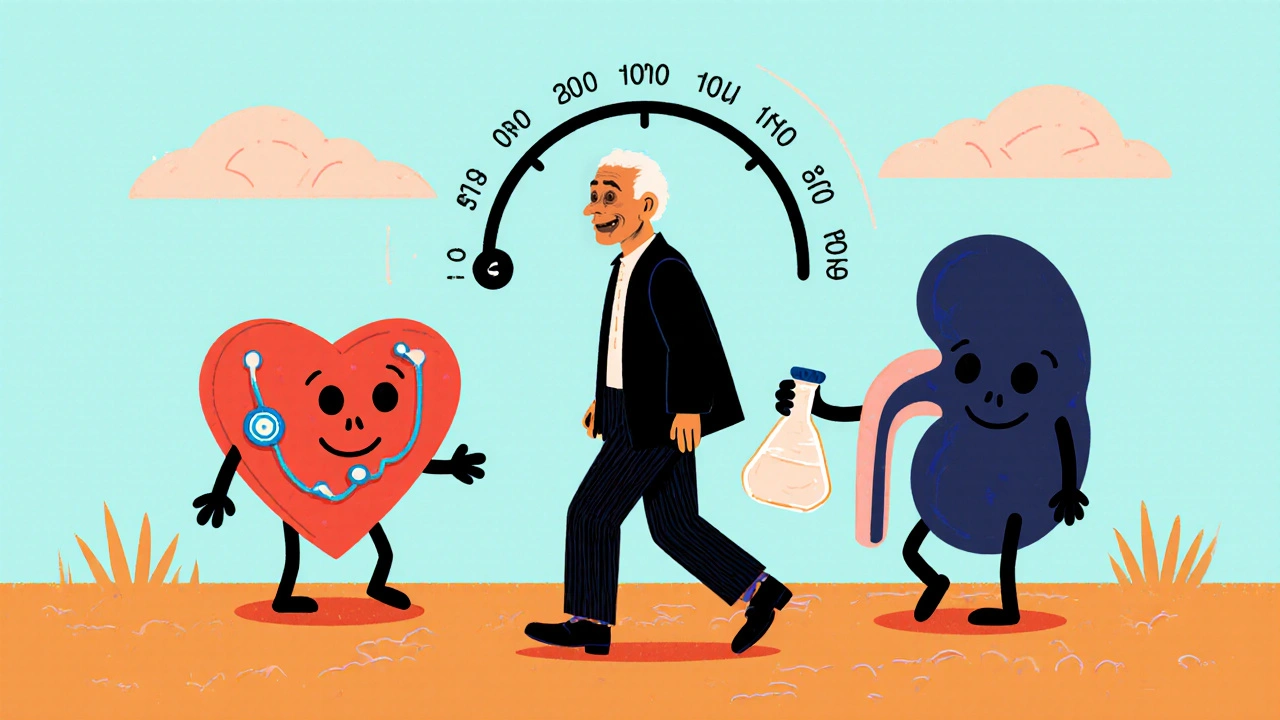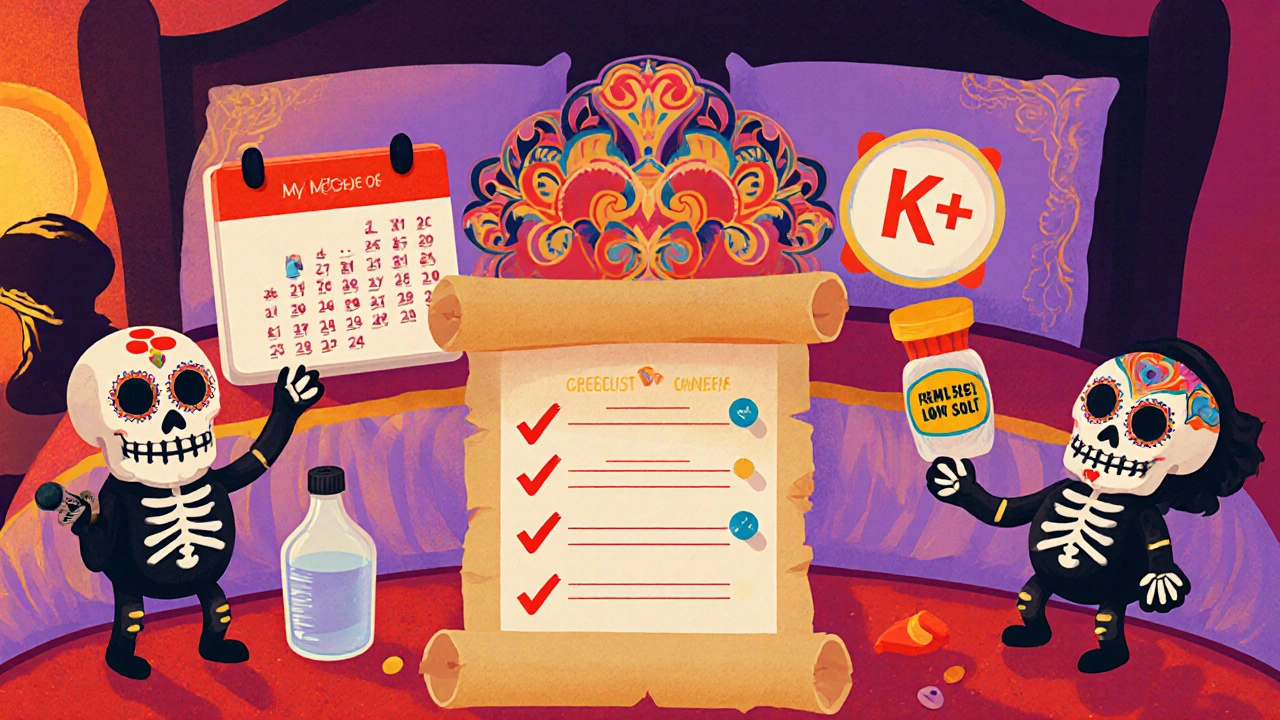Ramipril Dosage Calculator for Seniors
• Monitor blood pressure closely during dose titration
• Check potassium and kidney function within 1-2 weeks
• Stop immediately if you experience swelling, difficulty breathing, or severe cough
Ramipril is an ACE inhibitor used primarily to manage high blood pressure and heart failure. It works by relaxing blood vessels, which helps the heart pump more efficiently.
When a doctor prescribes an ACE inhibitor to a 78‑year‑old, the most common name you’ll hear is Ramipril. But why does this drug matter more for seniors than for younger adults? The answer lies in how the aging body handles blood pressure, heart stress, and kidney function. Below we unpack the real‑world benefits, the dosing tricks that keep side effects at bay, and the red‑flag precautions every caregiver and patient should know.
How Ramipril Helps Elderly Patients
In older adults, Hypertension is a leading cause of strokes and heart attacks. Ramipril lowers systolic pressure by about 10‑15 mmHg on average, which translates into a measurable drop in cardiovascular events. Studies from the American Heart Association in 2023 showed that seniors on Ramipril had a 20 % lower risk of hospitalization for heart failure compared with those on older β‑blockers.
Beyond blood pressure, Ramipril offers two extra shields for seniors:
- Heart failure protection - By reducing after‑load, the drug eases the work of a stiffened heart, improving exercise tolerance.
- Kidney preservation - For patients with Chronic kidney disease, ACE inhibition slows the decline of glomerular filtration rate, delaying the need for dialysis.
Dosage Basics for the Over‑65 Crowd
Older bodies process medication slower, so starting low is key. The typical initiation dose for a senior is 1.25 mg once daily, gradually titrated up to 5 mg as tolerated. For patients with reduced kidney function (eGFR < 30 mL/min/1.73 m²), the maximum daily dose should not exceed 2.5 mg.
When adjusting the dose, watch for:
- Orthostatic dizziness - a sign the dose might be too high.
- Persistent cough - an ACE‑inhibitor side effect that often prompts a switch.
- Lab results that show rising potassium or worsening creatinine.
Common Precautions and Side Effects
Even though Ramipril is generally well‑tolerated, seniors are more vulnerable to a few reactions:
- Cough - A dry, nagging cough occurs in up to 12 % of users and may be more pronounced in smokers.
- Hyperkalemia - Elevated potassium can reach dangerous levels, especially when combined with potassium‑sparing diuretics.
- Low blood pressure (hypotension) - Particularly after the first dose or when standing up quickly.
- Impaired Kidney function - A rise in serum creatinine >30 % signals the need to reassess therapy.
- Angioedema - Swelling of the lips or throat, though rare (<0.1 %), requires immediate medical attention.

Drug Interactions to Watch in Older Adults
Polypharmacy is common after 65, and certain medicines can magnify Ramipril’s risks:
| Medication | Interaction | Management Tip |
|---|---|---|
| Non‑steroidal anti‑inflammatory drugs (NSAIDs) | Can blunt blood‑pressure‑lowering effect and worsen kidney function | Use acetaminophen when possible; monitor creatinine |
| Potassium‑sparing diuretics (e.g., spironolactone) | Increase risk of hyperkalemia | Check potassium weekly for the first month |
| Lithium | Reduced lithium clearance → toxicity | Adjust lithium dose and monitor serum levels |
| Other ACE inhibitors or ARBs | Duplicate renin‑angiotensin blockade | Avoid concurrent use |
In addition, over‑the‑counter supplements like potassium chloride should be taken only after discussing with a clinician.
When Not to Use Ramipril
There are clear situations where Ramipril should be avoided outright:
- History of Angioedema related to previous ACE‑inhibitor therapy.
- Pregnancy - ACE inhibitors can harm the developing fetus.
- Severe renal artery stenosis - The drug may further reduce kidney perfusion.
- Critical hypotension - Systolic pressure <90 mmHg before the next dose.

Practical Tips for Patients and Caregivers
Ensuring safe use isn’t just about pills; daily habits matter.
- Take Ramipril at the same time each day, preferably in the morning with a light meal.
- Maintain a low‑salt diet; excess sodium can counteract the blood‑pressure benefit.
- Stay hydrated, but avoid excessive potassium‑rich foods (bananas, oranges) if you’re on a potassium‑sparing diuretic.
- Schedule lab checks: baseline creatinine and potassium, then repeat at 1‑2 weeks after any dose change.
- Keep a medication list handy and share it with every new healthcare provider.
Quick Reference Checklist
- Start at 1.25 mg daily; titrate slowly.
- Monitor blood pressure, creatinine, and potassium.
- Watch for cough, dizziness, swelling.
- Avoid NSAIDs and potassium supplements without doctor approval.
- Stop immediately if you develop facial swelling or trouble breathing.
Frequently Asked Questions
Can Ramipril be taken with my blood‑pressure pill?
Yes, Ramipril is often combined with thiazide diuretics or calcium‑channel blockers to achieve better control. Your doctor will adjust doses to avoid low blood pressure.
What should I do if I develop a dry cough?
Report it to your physician. In many cases the cough disappears after switching to an ARB, which works similarly without triggering the cough reflex.
How often should my labs be checked?
Baseline labs before starting, then 1-2 weeks after the initial dose or any change, and every 3-6 months thereafter, especially if you have kidney disease.
Is it safe to stop Ramipril suddenly?
Stopping abruptly can cause a rebound rise in blood pressure. Always taper under medical supervision.
Can Ramipril help with heart failure?
Yes, clinical trials show that ACE inhibitors like Ramipril reduce mortality and hospitalizations in systolic heart failure, which is common among older adults.








